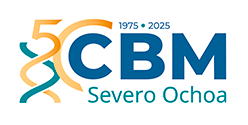Scientific Program
Tissue and organ homeostasis
RESEARCH GROUP
Functional interactions between tetraspanin CD9 and cell adhesion molecules

Carlos Cabañas
Extracellular vesicles play key roles in tumor development, progression and metastasis in many types of cancer. Tumor exosomes, which are very abundant in the malignant ascites of colorectal (CRC) and ovarian (OvC) cancer patients, promote formation of the pre-metastatic niche and peritoneal metastasis. The mechanisms involved in this process include induction of immunosuppression and immune evasion, stromal remodeling associated with generation of cancer-associated fibroblasts (CAFs), and recruitment and induction of NETs (Neutrophil Extracellular Traps) in neutrophils. To achieve these effects, peritoneal exosomes must interact with (and be taken up by) different immune and non-immune target cells, in which they induce crucial phenotypical and functional changes. The effects caused by exosomes in their recipient target cells include: (1) immunosuppression by induction of apoptosis in dendritic and T cells and/or inhibition of activation in CD8+ T cells; (2) induction of pro-metastatic NETosis in neutrophils; (3) facilitation of direct attachment of cancer cells to the mesothelium, which is the initial crucial step in peritoneal metastasis; (4) induction of MMT reprogramming into cancer-associated fibroblasts (CAFs) and/or apoptosis in peritoneal mesothelial cells (PMCs); (6) transference of a more aggressive/invasive phenotype amongst cancer cells. Although the promoting effect of exosomes in peritoneal metastasis has been established, the knowledge on the specific molecules involved in this plethora of interactions between tumor-derived exosomes and immune and non-immune target cells in CRC and OvC is at present rather scarce. The central objective of our group is the identification and functional characterization of the molecular determinants involved in the docking and uptake of CRC- and OvC-derived extracellular vesicles by target cells.
Research
Tetraspanins are highly conserved membrane proteins that function as membrane-organizers and control fundamental cell functions, including adhesion, migration and proliferation. The tetraspanin CD9 specifically associates with different adhesion receptors of the immunoglobulin and integrin families in tetraspanin-enriched microdomains (TEMs). Through these interactions, CD9 exerts important regulatory effects on the function of associated adhesion molecules. Our group has reported that CD9 associates directly with the metalloproteinase ADAM17 on the surface of different types of cells, exerting an inhibitory effect on ADAM17 sheddase activity against a variety of its substrates. Interactions of integrin α5β1 with ADAM17 may occur among molecules expressed on the same cell (cis) or on different cells (trans), with the latter reported to support cell-cell adhesion events. Interestingly, the interaction between integrin α5β1 and the disintegrin domain of ADAM17 has been shown to cause the inhibition of both the adhesive capacity of the integrin (i.e. its ability to bind its ligands) as well as of ADAM17 metalloproteinase activity due to steric hindrance leading to decreased accessibility of its catalytic site for the substrate. In contrast, stimuli that promote the dissociation of the α5β1-ADAM17 complex induce the activation of ADAM17 sheddase activity and increase integrin-mediated cell adhesion. Interestingly, the expression of CD9 on the cell surface abrogates integrin α5β1-mediated cell adhesion to its ligands fibronectin and ADAM17-Fc. In situ proximity ligation assays (PLA) and biochemical experiments based on co-immunoprecipitation collectively revealed that the mechanism by which CD9 inhibits α5β1-mediated cell adhesion involves the reinforcement of cis interactions between ADAM17 and α5β1 on the cell surface, which takes place without alteration in α5β1 integrin affinity but is evidenced by changes in the organization of integrin molecules at the plasma membrane.
Exosomes are a type of extracellular vesicles (EVs) of endocytic origin which serve important intercellular communication functions. Exosomes are produced and released by a large variety of donor cells in the organism and contain a specific cargo of lipids, proteins, miRNAs, mRNAs and DNA which, upon their selective binding and/or uptake can modify the phenotype and trigger a functional response in target cells. Tetraspanins are very abundantly expressed on the surface of different types of extracellular vesicles (EVs), including exosomes, and many research groups consider these proteins as the best markers for these EVs. Our group is currently investigating the role of CD9 as a regulator of adhesion molecules and metalloproteinases involved in the binding and/or uptake of exosomes by target cells.
Group members

Carlos Cabañas Gutiérrez
Lab.: 125 Ext.: 4513
ccabanas(at)cbm.csic.es

Irene Clares Pedrero
Lab.: 125 Ext.: 4513
irene.clares(at)cbm.csic.es

Almudena Rocha Mulero
Lab.: 125 Ext.: 4513
arocha(at)cbm.csic.es

Lara Álvarez Rodríguez
Lab.: 125 Ext.: 4531
lalvarez(at)cbm.csic.es
Selected publications
Title
Authors
Title
Authors
Title
Authors
Title
Authors





